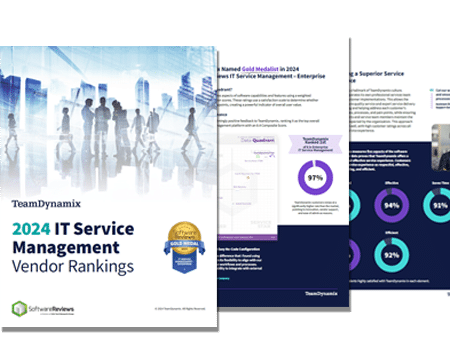
Enterprise Service Management: Why a Unified Platform Matters
Enterprise Service Management (ESM) is the practice of extending IT Service Management (ITSM) principles beyond the IT department to other areas of an organization. ESM

The Info-Tech ranking report offers a unique view of the market based entirely on in-depth customer interviews. Download the Info-Tech ITSM Quadrant and Customer Viewpoint report today.

We’ll show you some of our best situations and show you exactly how to execute them to get immediate results. The best part is, iPaaS tools often feature easy-to-use click and drag functionality, meaning you don’t need a dedicated employee building integrations and workflows.

System Integrators, Value Added Resellers, Technology Providers, and Buying Consortiums can benefit from a partnership with TeamDynamix.

The Info-Tech ranking report offers a unique view of the market based entirely on in-depth customer interviews. Download the Info-Tech ITSM Quadrant and Customer Viewpoint report to gain a better understanding of key vendor strengths and emerging market requirements.
When it comes to improving IT Service Management (ITSM) maturity, many organizations turn to ITIL – a framework that guides users through a process-based approach to the management and continuous improvement of information technologies and services. By using ITIL, IT services within organizations can keep pace with the overall needs and goals of the business or institution; all while delivering exceptional service to customers, employees and other end-users.
ITIL stands for Information Technology Infrastructure Library, and describes the processes, procedures, tasks and checklists that can be applied by an organization as part of an overall IT strategy; to improve customer delivery; or to maintain a certain level of competency organization-wide. Those wanting to use ITIL can get certified – the latest iteration being ITIL 4.
ITIL 4 provides the guidance organizations need to address new service management challenges and harness the potential of modern technologies in the age of cloud, agile and DevOps transformations. A vital component of the ITIL 4 framework is the use of a single, uniform and cohesive set of guidelines for the management of IT services.
When thinking about ITIL vs ITSM, it’s important to understand the relationship between the two.
ITSM describes how an organization manages its IT services, and ITIL is a framework for ITSM – a specific set of processes and guidelines for the provisioning of IT services. It’s not really a one vs. the other comparison, and having strategies for both is vital to building out a mature IT offering.
A useful analogy would be the concept of project management and the various project management methodologies available. While project management describes the standardization of processes any given organization uses to manage its projects, methodologies such as Agile and Waterfall prescribe their own specific frameworks for managing projects in particular ways.
There are many benefits to using ITIL as part of your strategy to improve service management and delivery. Some of the key benefits are:
The ITIL framework bases itself on the five phases of the service life cycle. The guidelines set out the necessary processes, associated challenges and best practices for each phase of the service life cycle, as well as the requirements for the implementation of each phase. It is important to keep in mind that these are guidelines and that the framework should be used to facilitate internal discussion and policy creation to optimize service delivery.
While ITIL v3 defined several processes for organizing the service life cycle, ITIL 4 describes the principles, concepts and practices in more detail. Additional guidance ensures that practitioners better understand the impact of each phase. ITIL 4 also provides a framework for integrating ITIL with other services such as cloud, mobile and cloud-as-a-service.
Many institutions are implementing ITIL to ensure they have a common vocabulary and methodology surrounding request fulfillment and incident response. Increased demands for online and blended learning experiences put pressure on higher-ed IT organizations, but IT budgets are staying static or even decreasing.
TeamDynamix ITSM makes a positive impact when paired with ITIL in higher education. Yancy Philips, IT Team Director for Indiana State University, explains how their old basic ticketing system that was used to manage the delivery of IT service “served its purpose for many years, but as we started to adopt more ITIL best practices and worked to improve our service delivery, we knew we needed something more.”
That something more was TeamDynamix.
“People are thrilled with our service now,” Philips says. Likewise, in an ever-connected world, state and local governments need to provide new services and keep up with changing needs while often balancing tight budgets.
Implementing IT Service Management (ITSM) best practices enables organizations to standardize and optimize the way they respond to the ever-increasing demand while keeping operational costs low and customer satisfaction high.
Dusty Borchardt, Business Systems Manager for Oklahoma City, says that they adopted the ITIL framework more than 15 years ago. He explains that they’d had effective processes in place for a while, but they “haven’t had a decent toolset to manage them” until they utilized TeamDynamix’s ITSM platform.
“TeamDynamix has brought simplicity to our operations,” Borchardt says. “This is the first IT Service Management platform we’ve implemented that everyone loves to use.”
It’s a similar story at the City of Goodyear.
A few years ago, the City of Goodyear didn’t have any way to track the status of IT projects. The city government had a ticketing system for managing the delivery of IT services but this system was very limited in what it could do and what information it could provide.
“We wanted to increase the maturity of our IT operations by moving to ITIL processes,” Lisa Faison, deputy CIO for the City of Goodyear, Arizona, municipal government, said.
This meant bringing the oversight of IT services and projects together under a single platform for IT Service Management (ITSM) and Project Portfolio Management (PPM) that gave leaders a holistic view of the work employees were doing. What’s more, the platform had to allow for simple configuration and automation of IT processes, without a lot of coding or administration needed on the back end.
TeamDynamix has aptly met these requirements, positioning the city well for growing its IT maturity.
One year into using TeamDynamix, having better visibility into project and service information has helped the city’s IT department improve customer service for employees—and the city has only begun to scratch the surface of what the platform enables.
As Goodyear’s IT maturity continues, Faison and her colleagues will be looking to use the data they collect on IT projects to accurately forecast the amount of time that new projects will take, so they can allocate resources to projects more effectively. They also plan to help other city departments use TeamDynamix for enterprise-level service and project management.
Faison’s advice for getting the most out of the platform: “Think about what questions you’d like to ask of the data you’re collecting.” TeamDynamix is a powerful tool for supporting data-driven decision-making, she notes—and understanding what you’d like to know can help organizations take full advantage of the platform’s capabilities.

Enterprise Service Management (ESM) is the practice of extending IT Service Management (ITSM) principles beyond the IT department to other areas of an organization. ESM

As businesses grow, so does the complexity of managing their services. This is where Enterprise Service Management (ESM) comes in, offering a structured approach to

As IT departments modernize their service management tech stacks, automation stands out as a pivotal force driving significant transformations in how the IT service desk
TeamDynamix’s award-winning SaaS cloud solution offers IT Service and Project Management together on one platform with enterprise integration and automation.
[email protected]
(877) 752-6196
Contact Us
